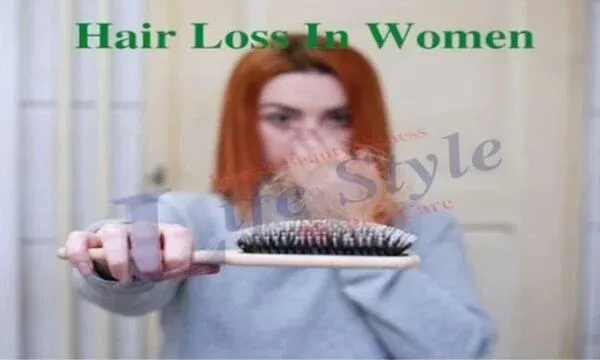Have you observed a steady rise in the number of hairs lost after combing or brushing?
If you have considerable hair loss, increased hair shedding, or breaking, you are not alone With wigs, hair extensions, hats, or scarves, many women may conceal it.
Others opt for one of the numerous licensed drugs or surgeries that are readily available to treat baldness. Although it's commonly believed that only males experience excessive hair loss or thinning, women account for up to 40% of hair loss patients in the United States.
One in four American women, or over 30 million, search for solutions to their hair loss each year. First of all, keep your cool.
It is typical to lose a small amount of scalp hair each day because hair loss or shedding occurs continuously during the hair development cycle.
The regular hair growth cycle causes about 100 to 150 individual hairs to become loose or shed every day from the 100,000 to 150,000 individual hairs that make up the average human scalp.
These same previously dormant hair follicles subsequently produce new hair growth, which grows on average at a rate of around half an inch each month.
The two separate components of hair are the follicle and the hair shaft.
The hair follicle, which is found beneath the scalp, is responsible for producing the hair strands that stick out from our heads. Although the follicle is active, the hair strand is totally composed of dead cells that are incapable of regeneration.
For the majority of us, 90% of our scalp hair is always in the anagen phase of development, which lasts from one to six years, and the remaining 10% is in the telogen phase of dormancy, which lasts for about three months.
The hair is shed when the dormant stage is through; these are the pesky hairs we worry about finding in our combs, hairbrushes, pillows, or shower drains. Unexpected hair loss is totally normal. Calm down.
When the natural pattern of hair growth is disturbed, it results in baldness or alopecia. Normally, human hair grows, rests, sheds, and then begins to grow once again. If there is an imbalance in the growth pattern, hair does not return as rapidly as it is shed.
Your risk of going bald is increased if androgenetic alopecia runs in your family. Heredity also affects the age at which you begin losing hair as well as the intensity, pattern, and development of your baldness.
The important treatments for Hair Care :
They frequently serve as the body's gauge for assessing whether it is in excellent or bad health. On the human scalp, three different forms of hair may be found. After shampooing, dry hair can seem lifeless and is frequently difficult to manage.
Their ends are cracked and dry. The oil glands dry out the hair when they stop producing any oil. Care and nutrition are essential for dry hair. They frequently have a thin, fragile, and abrasive appearance. The structure of hair is similar to the fish scales on its skin, which are made up of overlapping scales that surround a cortical core in the middle.
The hair seems more lustrous and silky with smoother overlapping. In contrast to a tangled or roughed-up structure, which makes the hair seem coarse and drab, this also makes combing easier. Two important variables that affect the health of the hair are diet and way of life.
The quality of the hair is affected by poor food, disease, and vitamin and mineral shortages, and the hair is ruined by issues like dandruff, thinning hair, balding, premature greying, etc. An individual's hair condition is a reflection of his overall constitution. The health of the hair will be appalling if the individual is not healthy.
Several typical hair-related issues Dandruff is one of the biggest hair concerns. Dandruff is a term for the flaky, itchy, dry skin that develops on the scalp.
Hair loss is considered to be a hair loss problem when the amount of hair loss increases beyond the natural hair fall that occurs as a result of a change in environment, advancing age, or the creation of new hairs. A few factors that contribute to hair loss include improper or bad nutrition, exposure to numerous chemicals or cosmetics, hormonal imbalance, stress, worry, and mental strain.
Hair that begins to grey before the age of 35 is said to be prematurely greying, which is caused by the aggravation of the Pitta dosha. Graying the hair is a normal process that happens with aging. Itchy scalp: An itchy, red scalp with small pimples or blisters, dull, lifeless hair, and aggravation of Pitta dosha are caused by stress, allergens in shampoo, air conditioning, pollution, and central heating.
More salads, green leafy vegetables, milk, fruits, and sprouts should be included in the diet. Proteins, milk, buttermilk, yeast, wheat germ, soybeans, and vitamin A should all be increased. It's crucial to brush and clean your hair frequently. Oil-producing glands in the scalp are activated when the hair is brushed. This organic oil gives the hair a healthy sheen. After shampooing, rinse your hair with a cup of warm water and some lemon juice to give it more shine. Homeopathic
Treatments for Hair Care
1. Zinc deficiency is the primary cause of dry hair, hence a diet high in zinc should be followed.
2. Rosemary works well as a conditioner and tonic for hair. Rosemary also aids in color retention, particularly for black hair.
10. Combine 1 egg yolk, 1-2 tablespoons of olive oil, and 2-3 drops of vitamin E for an excellent hair conditioner. Combine these, moisten your hair, then work the mixture through it. Allow to sit for three to five minutes; it may seem odd or smell off, but it works wonders. With shampoo, clean up.

